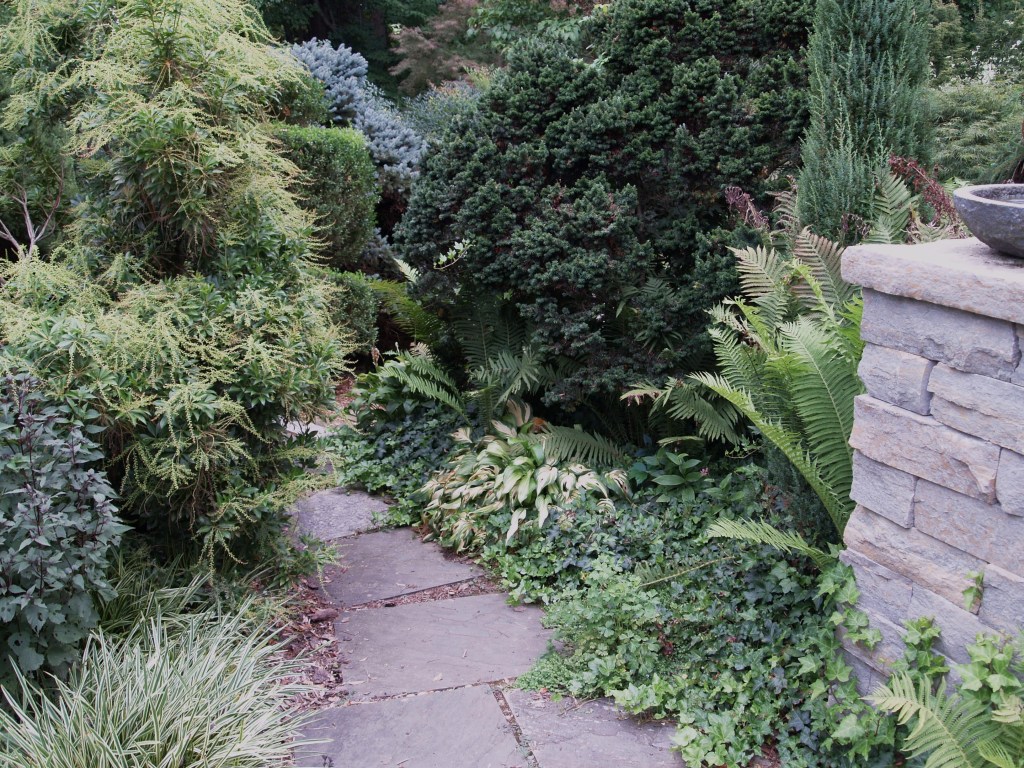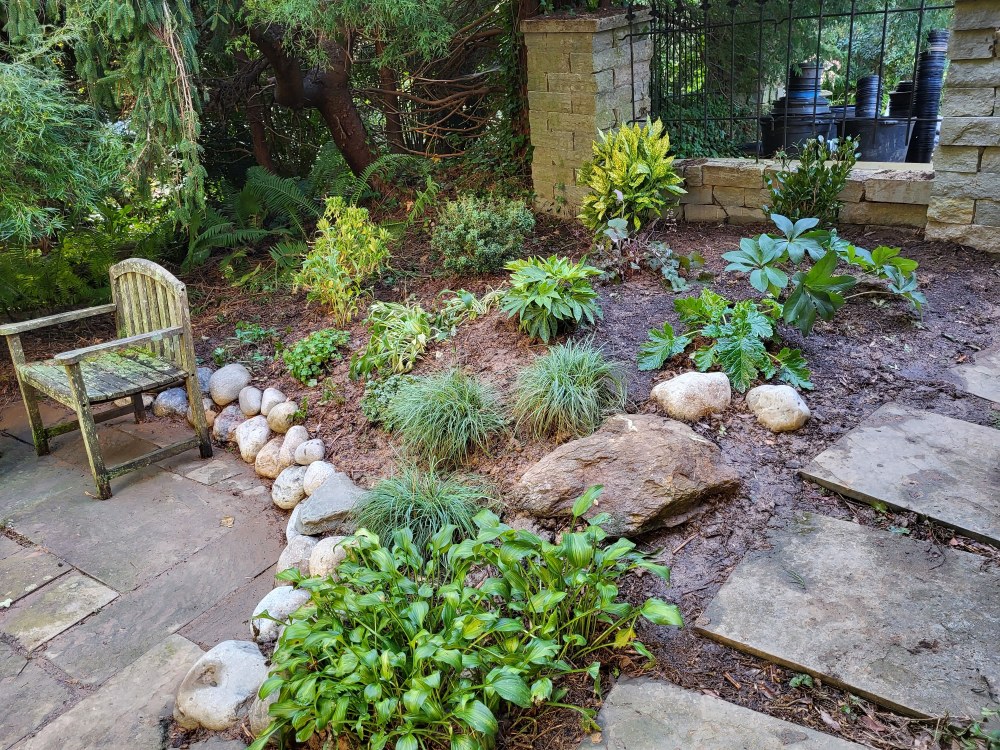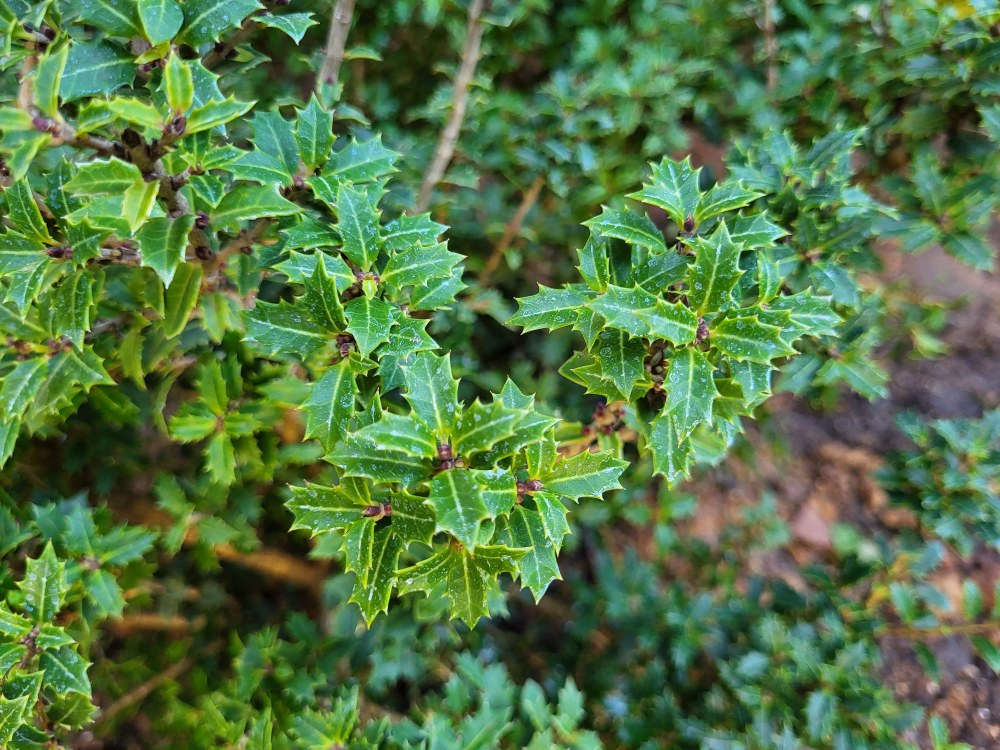I must put a stop to this disturbing trend. One of the oldest (and neglected) areas in the garden was recently chopped out to make room for workers to construct a sunroom in place of our shabby deck. A treasured ‘Moonrise’ Japanese maple and several unusual plants have gone in (with room to spare for the construction to be filled later), so suddenly I’m inspired and considering removing the long established planting on the far side of the same circular patio. Despite pleas from my wife, the very wide spreading, green leafed, pendulous branched Japanese maple will not be touched. I’m happy to have it continue to obstruct a portion of the patio.

While the globose blue spruce and boxwood recently cut out dated back to the earliest plantings in this thirty-four year old garden, the current bed of Ostrich ferns and a few hostas is the third, maybe the fourth planting in this small area. As I recall, and my recollection is often muddled, a pollarded paulownia (Paulownia tomentosa) once occupied this space. Annually, it was chopped to the ground so that its tall growth was managed. Pollarding also eliminated the tree’s splendid flowers, but I was after the huge leaves that resulted. Finally, I decided this was more work than I cared for, and despite starting the year at a foot in height, the paulownia grew to ten feet tall very quickly with multiple branches that were out of place alongside this small, circular patio.

The next planting was greatly improved in scale, with a wonderful dwarf hemlock (above) as the centerpiece. It started big (for a dwarf) and slowly grew over years to fill the space. But then it faded, turning off color in the autumn without an obvious cause, then dying over the winter. Distracted by planting other parts of the garden, the hemlock was pulled out and Ostrich ferns were allowed to take over. And, that’s how it’s been for several years.
The Ostrich ferns are cut back in late winter, and in early spring the shuttlecocks are marvelous as they rise (below), then turn to a lush colony of tall ferns. Yes, they lean over the path and patio, often send runners that pop up between path stones, and by late summer some turn brown along the edges in too much sun. It works, or it has worked for lack of any better idea in this largely neglected and forgotten area. But now, the far side of the circular patio has been partially replanted, and I’m getting the itch to jerk the ferns out to also renew this area.

Now that I’ve paid attention, the area is not as large as I imagined. The weeping green maple has spread, but even more, a threadbranch cypress ( Chamaecyparis pisifera filifera ‘Aurea’) now looms over a section of the area, diminishing even the Ostrich ferns. I must interrupt to warn that some varieties of goldthread cypress can grow far larger than expected. This one grew to eight feet or so in height and width, but then thrust a trunk of differently textured adult needles straight up another fifteen feet. This probably won’t work where yours is planted, though here it had the room to spread even if it wasn’t planned.
But, if new planting is to work as I envision it, the lower branches of the cypress will have to be removed or the march to shade the area will continue. This should be quite simple, and I don’t expect much trouble digging out the massive clumps of Ostrich ferns. I’ll clear the area before deciding what’s going back in, but here there is no conflict with the construction so I can plant as soon as I figure what to plant.
The deed is done
The ferns have been dug out with the exception of several growing beneath the Japanese maple. The lowest branches of the gold cypress have been removed, expanding the area considerably. The ferns are shallow rooted and with recent rain the moist soil was easily dug, so this was not particularly strenuous except the whole mess must still be carried to the debris pile. The remaining Ostrich ferns will fill the void beneath the maple, and if they eventually stray back into the newly planted area they’re easily removed. There was a good amount of English ivy growing through the clumps of ferns, so it has also been removed, but it’s likely a few scattered roots will have been missed so I’ll have to watch for this in the spring.

A few hostas will remain, but it’s likely I’ll have to dig out and relocate the long established clump of ‘Mediovariegata’ (above) that has been pushed by the ferns to the edge of the bluestone path. ‘Mediovariegata’ is one of a few hostas that at one time were the standard of variegated hostas (along with ‘Albo marginata’, also long forgotten), but now have been left far behind in the deluge of newer introductions. I plan to keep the antique as a reminder of the days when only a handful of hostas stocked garden center shelves, but also, I rather like it.

No doubt, renewing the planting in this area is a positive step. As it was, it wasn’t horrible, but just like the neighboring area that was recently cleaned out, I want this to be a highlight to be seen from the new sunroom, not a part of the garden that’s ignored and overlooked. My caution is not to get too excited by ripping out older parts of the garden. I can’t think of other areas at the moment that are similarly ignored and neglected, but a few weeks ago I moved almost instantly from arguing that everything has to stay as is to grabbing the chainsaw an hour later.

When I’m inspired, things move quickly. No planting or stone project is too much work (or too heavy, or hot). Barbara just shakes her head.